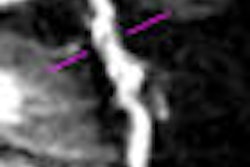SPECT/CT can help orthopedic surgeons and radiologists identify multiple arthritic joints in the feet and ankles and localize degenerative joint disease, according to a study published in the September issue of the British edition of the Journal of Bone and Joint Surgery.
The modality also can help surgeons and radiologists who have limited clinical experience to detect the arthritic joints in small, complex anatomic sites. The lead author of the study was Dr. Geert Pagenstert from the department of orthopedic and trauma surgery at the University Hospital Basel in Switzerland (J Bone Joint Surg, Vol. 91-B:9, pp. 1191-1196).
Finding the exact location of osteoarthritic conditions is crucial in determining the most appropriate surgical treatment for patients, the authors noted. Given SPECT/CT's ability to provide both morphologic and biologic information, the researchers hypothesized that the modality would increase physicians' ability to localize arthritic joints compared with conventional evaluations performed by CT and bone scanning.
The study included 20 consecutive patients with pain of uncertain origin in the feet and ankles, with 13 women and seven men (mean age, 60 years; range, 20-79). All 20 patients had a history of degenerative joint disease and were scanned with weight-bearing x-rays and hybrid SPECT/CT (Symbia T2, Siemens Healthcare, Erlangen, Germany).
The SPECT/CT system allowed the researchers to simultaneously register 3D scintigraphic SPECT bone scans with a dual-head gamma camera with technetium-99m and produce 3D CT scans. The simultaneous registration "produces highly accurate merging of SPECT and CT data which are available as fused SPECT/CT images or as a separate bone scan with a spatial resolution of 7 mm, and a CT scan with images of spatial resolution of less than 1 mm," the authors wrote.
Five observers evaluated the images for the presence or absence of joint degeneration. The reviewers consisted of one musculoskeletal radiologist who specialized in nuclear medicine, two orthopedic surgeons, and two orthopedic residents.
In their analyses, the mean intraobserver reliability for SPECT/CT was excellent (0.86; 95% CI: 0.81-0.88) and significantly higher than that of CT and bone scanning when measured independently. SPECT/CT also had "significantly higher interobserver agreement, especially when evaluating the naviculocuneiform and tarsometatarsal joints," the authors wrote.
By comparison, the mean intraobserver reliability for independent CT studies (0.67; 95% CI: 0.57-0.79) and separate bone scans (0.65; 95% CI: 0.59-0.73) were rated as good. The study noted that the difference between the values for CT and bone scanning was not statistically significant.
The researchers also compared the intraobserver reliability based on medical specialty and level of experience among the reviewers.
They determined that the intraobserver agreement was significantly increased by SPECT/CT in a side-by-side evaluation of CT and bone scanning "without significant differences between the levels of experiences" among the physicians evaluating the images. "SPECT/CT imaging appears to overcome lack of experience by displaying active joint degeneration in a nonambiguous way," the authors wrote.
SPECT/CT also showed prowess in its ability to identify arthritic joints in complex regions of the foot and ankle. With SPECT/CT, agreement among the reviewers was "perfect in all the anatomical areas of the foot and ankle and in selective areas with CT, bone scanning and CT, and bone scanning," they wrote.
Only in the more complex midfoot area with naviculocuneiform and tarsometatarsal joints did researchers find a "significantly higher agreement with SPECT/CT compared to side-by-side evaluation."
Based on the reviewers' evaluation, SPECT/CT "added value for the orthopedic surgeon and radiologist in localizing active degenerative joint disease in the foot and ankle with multiple arthritic joints," the researchers concluded.
The modality's benefit also is "most pronounced in small complicated anatomical sites and for observers with limited clinical experience," they wrote.
By Wayne Forrest
AuntMinnie.com staff writer
September 8, 2009
Related Reading
SPECT/CT outdoes planar imaging with lymph nodes, January 5, 2009
SPECT/CT once again shows value in bone lesion location, September 18, 2008
SPECT/CT mammography system produces first patient images, July 30, 2008
SPECT/CT offers better bone scan views to enhance treatment, September 21, 2007
SPECT/CT offers on-target diagnosis in noncancerous bone disease, March 23, 2007
Copyright © 2009 AuntMinnie.com



















